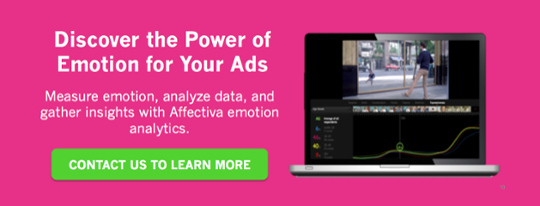By Graham Page, Global Managing Director, Media Analytics, Affectiva
New evidence from Unruly and Affectiva sheds new light on the mechanisms underlying successful advertising
Many studies, going back decades, have demonstrated that emotionally powerful advertising is more effective than simple rational messaging. Landmark studies such as the Binet and Field’s work looking at the UK IPA database, and the more recently launched Cannes Creative Ladder, show clearly that emotionally powerful advertising is more effective in the long run. Similarly, long-standing ad research businesses such as Kantar (Millward Brown) have shown that emotionally resonant ads are associated with strong sales results.
The greater understanding of cognitive psychology that has gathered pace in the marketing industry has given some theoretical underpinning for these effects–but a new study conducted by Unruly Media, using Affectiva data, and in conjunction with Richard Shotton (author of The Choice Factory), sheds further light on why more emotionally powerful ads are more effective–and it hinges on the relationship between emotion and memory.
Memorability is long established as a good cipher for advertising effectiveness–which makes sense, as few people decide to buy a product at the moment they are exposed to advertising. So most ad effects must be mediated by memory in some way. And emotion is long established as both a cue for attention within the brain, and has been shown to generate stronger memories. Our joint study sought to investigate one mechanism for this effect: the Peak-End rule. This is a psychological heuristic, whereby the perceived value and memories of an event are not simply based on the average of how we felt throughout an experience, but are preferentially influenced by how we felt that the emotional peak of the experience, and the end of the experience. In other words–how we feel at the high-points and end of an experience dominate how we feel about it, and what we remember. This has clear implications for advertisers: if feelings at key points in the ad influence its emotional appeal and memorability, then understanding if and when those points occur becomes critical to assessing, and maximising the effectiveness of the ad.
So we collaborated with Unruly in a simple experiment to assess if this rule holds true in advertising. Unruly has used Affectiva’s emotional AI technology for many years to help its clients optimize their ads–and based on this database, we identified 9 ads to test, which were split into three groups, based on the pattern of facial expressiveness seen when people watched them. The Control group showed an even pattern of emotional response, with few clear peaks. The Multiple Peaks group showed several emotional highs through the course of the ads, and the End-Peak group showed a clear emotional peak towards the end of the ad. The ads were shown to over 1200 members of a consumer research panel, approximately half of whom were then re-contacted one week later, to assess which ads they remembered, and which elements of the ads they could recall.
The results showed clear support for the power of emotion in driving memorability, and for the preferential role of emotional peaks:
- Ads in the multiple peaks and end-peak groups were on average significantly more likely to be recognized a week after being shown, than the control group
- People were more likely to recall the advertised brand from ads with strong emotional peaks than the control group
- People were more likely to correctly recall details of the ads with strong emotional peaks than the control group
These results are clearly in line with the Peak-End rule: ads with moments of high emotional intensity as measured on the face are more likely to be remembered, and specifically, key creative detail is more likely to be remembered. This will feel familiar to anyone who has worked in the ad industry long enough to remember “detailed recall” questions used widely in ad tracking the 1990s-2000s, which made it clear that viewers’ memories for ads are very selective. It also corroborates findings from other advertising researchers. For instance, Kantar (Millward Brown) have long discussed the phenomenon they refer to as the “Creative Magnifier” – whereby the engaging elements of ads dominate memories, and that in the most effective ads those peaks in engagement both involve the brand, and capture the core idea of the ad.
So–while the latest study is of relatively small scale, it clearly demonstrates that the peak-end rule plays a role in advertising effects, and it is something that advertisers need to take into account in creating and optimising copy. If we want to engage consumers with our ideas, emotional intensity is critical, and if we want those brand ideas to persist in memory, they need to be captured in the peak emotional moments in the ad. One of the ads in our “end-peaks” cell captured this perfectly: in the Maltesers “New Boyfriend” spot, the rude joke is a clear highlight–but also features the brand at its center as part of the punchline.
Key takeaways
The “Peak-end rule" plays a key role in advertising, and helps explain why ads that make people feel strong emotions are more likely to be effective. Ads with peaks in emotional intensity throughout or at the end are more likely to be recalled, and key creative detail is more likely to be recalled. Advertisers therefore need to think not just about telling emotionally compelling stories, but also about where the brand and key brand messaging appears within that story. A story whose highlights include the brand and key strategic ideas is more likely to be remembered, and therefore influence brand equity, than one that does not.
For more on how you can practically apply behavioral science to ensure your video ad is remembered for the right reasons, listen to this Total Media behave podcast where Unruly and Affectiva discuss how their recent research proves that Noble Prize Winner Daniel Kahneman’s ‘peak-end rule’ can positively work in advertising.


%20(1).jpg?width=600&height=400&name=shutterstock_552635788%20(1)%20(1).jpg)





